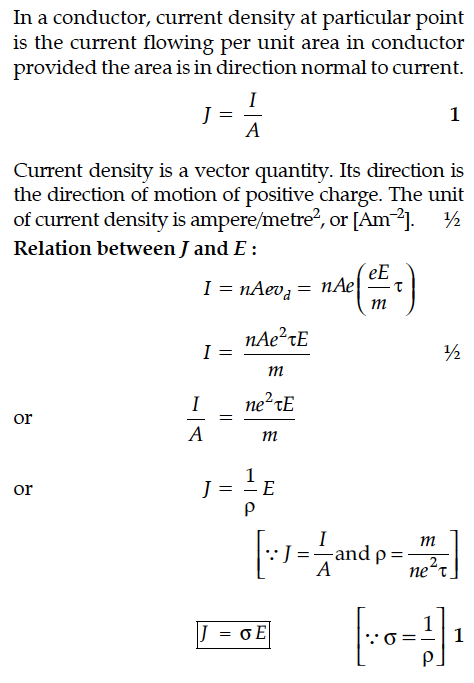Define the term current density of a metallic conductor. Deduce the relation connecting current density (J) and the conductivity σ of the conductor, when an electric field E, is applied to it.

Using the concept of drift velocity of charge carriers in a conductor, deduce the relationship between current density and resistivity of the conductor.
Write the expression for the drift velocity of charge carriers in a conductor of length l across which a potential difference V is applied.
When electrons drift in a metal from lower to higher potential, does it mean that all the free electrons of the metal are moving in the same direction ?
In the circuit shown in the figure, find the total resistance of the circuit and the current in the arm CD.
How does the random motion of free electrons in a conductor get affected when a potential difference is applied across its ends ?
In the two electric circuits shown in the figure, determine the readings of ideal ammeter (A) and the ideal voltmeter (V).
(i) Three point charges q, – 4q and 2q are placed at the vertices of an equilateral triangle ABC of side ‘l’ as shown in the figure. Obtain the expression for the magnitude of the resultant electric force acting on the charge q.
Two point charges + q and –2q are placed at the vertices ‘B’ and ‘C’ of an equilateral triangle ABC of side ‘a‘ as given in the figure. Obtain the expression for (i) the magnitude and (ii) the direction of the resultant electric field at the vertex A due to these two charges.
A source of ac voltage V = V₀ sin ωt is connected to a series combination of a resistor ‘R’ and a capacitor ‘C’. Draw the phasor diagram and use it to obtain the expression for
(i) impedance of the circuit and
(ii) phase angle.
Derive an expression for electric field of a dipole at a point on the equatorial plane of the dipole. How does the field vary at large distances?
What is relaxation time ? Derive an expression for resistivity of a wire in terms of number density of free electrons and relaxation time.
A student connects a cell, of emf E2 and internal resistance r2 with a cell of emf E1 and internal resistance r1, such that their combination has a net internal resistance less than r1. This combination is then connected across a resistance R. Draw a diagram of the 'set-up' and obtain an expression for the current flowing through the resistance.
A particle, having a charge +5 µC, is initially at rest at the point x = 30 cm on the x-axis. The particle begins to move due to the presence of a charge Q that is kept fixed at the origin. Find the kinetic energy of the particle at the instant it has moved 15 cm from its initial position if
(a) Q = +15 µC and
(b) Q = – 15 µC
